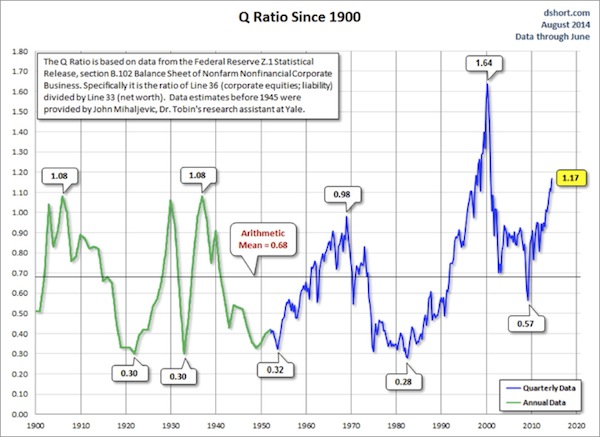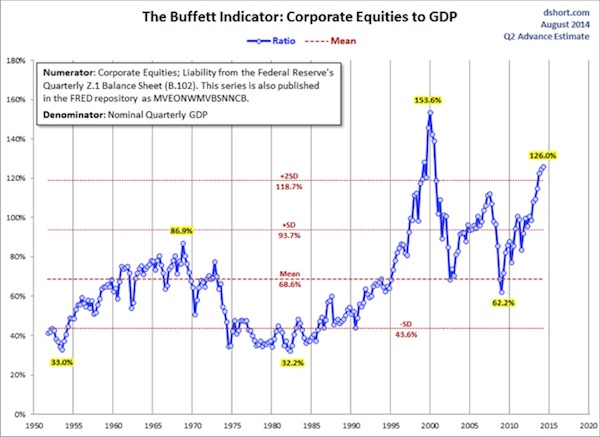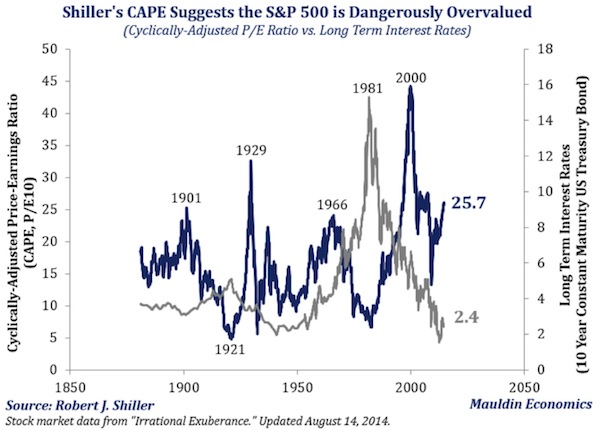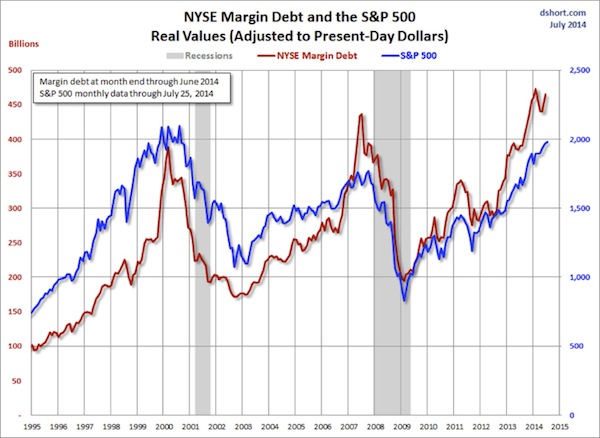Market Bubbles, Bubbles Everywhere
Stock-Markets / Liquidity Bubble Aug 19, 2014 - 11:15 AM GMTBy: John_Mauldin
 The difference between genius and stupidity is that genius has its limits.
The difference between genius and stupidity is that genius has its limits.
– Albert Einstein
Genius is a rising stock market.
– John Kenneth Galbraith
Any plan conceived in moderation must fail when circumstances are set in extremes.
– Prince Metternich
I'm forever blowing bubbles, Pretty bubbles in the air
They fly so high, nearly reach the sky, Then like my dreams they fade and die
Fortune's always hiding, I've looked everywhere
I'm forever blowing bubbles, Pretty bubbles in the air
– Burr and Campbell
You can almost feel it in the air. The froth and foam on markets of all shapes and sizes all over the world. It’s exhilarating, and the pundits who populate the media outlets are bubbling over. There’s nothing like a rising market to lift our moods. Unless of course, as Prof. Kindleberger famously cautioned (see below), we are not participating in that rising market. Then we feel like losers. But what if the rising market is … a bubble? Are we smart enough to ride it high and then bail out before it bursts? Research says we all think that we are, yet we rarely demonstrate the actual ability.
My friend Grant Williams thinks the biggest bubble around is in complacency. I agree that is a large one, but I think even larger bubbles, still building, are those of government debt and government promises. When these latter two burst, and probably simultaneously, that will mark the true bottom for this cycle now pushing 90 years old.
So, this week we'll think about bubbles. Specifically, we'll have a look at part of the chapter on bubbles from Code Red, my latest book, coauthored with Jonathan Tepper, which we launched late last year. I was putting this chapter together about this time last year while in Montana, and so in a lazy August it is good to remind ourselves of the problems that will face us when everyone returns to their desks in a few weeks. And note, this is not the whole chapter, but at the end of the letter is a link to the entire chapter, should you desire more.
As I wrote earlier this week, I am NOT calling a top, but I am pointing out that our risk antennae should be up. You should have a well-designed risk program for your investments. I understand you have to be in the markets to get those gains, and I encourage that, but you have to have a discipline in place for cutting your losses and getting back in after a market drop.
There is enough data out there to suggest that the market is toppy and the upside is not evenly balanced. Take a look at these four charts. I offer these updated charts and note that some charts in the letter below are from last year, but the levels have only increased. The direction is the same. What they show is that by many metrics the market is at levels that are highly risky; but as 2000 proved, high-risk markets can go higher. The graphs speak for themselves. Let’s look at the Q-ratio, corporate equities to GDP (the Buffett Indicator), the Shiller CAPE, and margin debt.




We make the case in Code Red that central banks are inflating bubbles everywhere, and that even though bubbles are unpredictable almost by definition, there are ways to benefit from them. So, without further ado, let’s look at what co-author Jonathan Tepper and I have to say about bubbles in Chapter 9.
Easy Money Will Lead to Bubbles and How to Profit from Them
Every year, the Darwin Awards are given out to honor fools who kill themselves accidentally and remove themselves from the human gene pool. The 2009 Award went to two bank robbers. The robbers figured they would use dynamite to get into a bank. They packed large quantities of dynamite by the ATM machine at a bank in Dinant, Belgium. Unhappy with merely putting dynamite in the ATM, they pumped lots of gas through the letterbox to make the explosion bigger. And then they detonated the explosives. Unfortunately for them, they were standing right next to the bank. The entire bank was blown to pieces. When police arrived, they found one robber with severe injuries. They took him to the hospital, but he died quickly. After they searched through the rubble, they found his accomplice. It reminds you a bit of the immortal line from the film The Italian Job where robbers led by Sir Michael Caine, after totally demolishing a van in a spectacular explosion, shouted at them, “You’re only supposed to blow the bloody doors off!”
Central banks are trying to make stock prices and house prices go up, but much like the winners of the 2009 Darwin Awards, they will likely get a lot more bang for their buck than they bargained for. All Code Red tools are intended to generate spillovers to other financial markets. For example, quantitative easing (QE) and large-scale asset purchases (LSAPs) are meant to boost stock prices and weaken the dollar, lower bonds yields, and chase investors into higher-risk assets. Central bankers hope they can find the right amount of dynamite to blow open the bank doors, but it is highly unlikely that they’ll be able to find just the right amount of money printing, interest rate manipulation, and currency debasement to not damage anything but the doors. We’ll likely see more booms and busts in all sorts of markets because of the Code Red policies of central banks, just as we have in the past. They don’t seem to learn the right lessons.
Targeting stock prices is par for the course in a Code Red world. Officially, the Fed receives its marching orders from Congress and has a dual mandate: stable prices and high employment. But in the past few years, by embarking on Code Red policies, Bernanke and his colleagues have unilaterally added a third mandate: higher stock prices. The chairman himself pointed out that stock markets had risen strongly since he signaled the Fed would likely do more QE during a speech in Jackson Hole, Wyoming, in 2010. “I do think that our policies have contributed to a stronger stock market, just as they did in March of 2009, when we did the last iteration [of QE]. The S&P 500 is up about 20 percent plus and the Russell 2000 is up 30 percent plus.” It is not hard to see why stock markets rally when investors believe the most powerful central banker in the world wants to print money and see stock markets go up.
To continue reading this article from Thoughts from the Frontline – a free weekly publication by John Mauldin, renowned financial expert, best-selling author, and Chairman of Mauldin Economics – please click here.
John Mauldin Archive |
© 2005-2022 http://www.MarketOracle.co.uk - The Market Oracle is a FREE Daily Financial Markets Analysis & Forecasting online publication.



